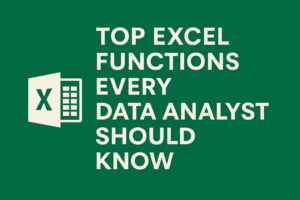Learn the critical difference between correlation and causation in data analytics. Explore real-world examples, common pitfalls, and techniques to validate causal relationships.
In the world of data analytics, one of the most dangerous assumptions you can make is that correlation implies causation. Misinterpreting these concepts can lead to flawed strategies, bad decisions, and misleading insights.
In this post, we’ll break down:
- The difference between correlation and causation
- Real-world examples where this confusion occurs
- How to test for causality
- Best practices to avoid common pitfalls
🔍 What is Correlation?
Correlation measures the degree to which two variables move together. It quantifies the strength and direction of a relationship.
📈 Pearson Correlation Coefficient (r)
- Ranges from -1 to +1
- +1 = perfect positive linear relationship
- 0 = no linear relationship
- -1 = perfect negative linear relationship
import pandas as pd
import seaborn as sns
import matplotlib.pyplot as plt
# Example: synthetic data
df = sns.load_dataset('tips')
df.corr(numeric_only=True)
Important: Correlation only shows association, not cause.
🔗 What is Causation?
Causation means that one variable directly affects another. For example, smoking causes an increase in the risk of lung cancer—this is not just correlation; it’s causality proven through controlled studies.
Establishing causality requires more than just observing patterns. It often involves:
- Randomized controlled trials (RCTs)
- Longitudinal studies
- Statistical controls (e.g., regression, instrumental variables)
🧠 Why Correlation ≠ Causation
Here’s a classic example:
Ice cream sales and drowning incidents are highly correlated.
Does eating ice cream cause drowning? Of course not.
Confounding Variable: Summer is the real cause of both. More people swim and buy ice cream when it’s hot.
⚠️ Real-World Examples
1. Marketing Analytics
- Observation: Customers who click an ad are more likely to buy.
- Mistake: Assume the ad caused the sale.
- Fix: Use A/B testing to measure lift in conversions.
2. HR Analytics
- Observation: Employees with longer tenures are more productive.
- Mistake: Assume longer tenure causes productivity.
- Reality: High performers might stay longer due to job satisfaction or promotions.
3. Healthcare
- Observation: People who take vitamins report better health.
- Issue: Health-conscious people might do many other things (eat better, exercise).
- Solution: Use matched samples or propensity score matching.
🛠️ Techniques to Test for Causality
1. Randomized Controlled Trials (RCTs)
- Randomly assign treatment vs. control groups.
- Gold standard in medicine, marketing, and experimentation.
2. Regression Analysis with Controls
- Use multiple regression to control for confounding variables.
import statsmodels.api as sm
X = df[['total_bill', 'size']]
y = df['tip']
X = sm.add_constant(X)
model = sm.OLS(y, X).fit()
model.summary()
3. Granger Causality (Time Series)
- Determines if one time series can predict another.
4. Instrumental Variables
- Use a third variable (instrument) that affects the independent variable but not the dependent variable directly.
5. Causal Inference Libraries
📌 Summary Table
| Aspect | Correlation | Causation |
|---|---|---|
| Definition | Measures association | Measures influence |
| Direction | Bidirectional | Unidirectional |
| Evidence | Observational | Experimental or controlled |
| Common Tools | Correlation coefficient, heatmaps | RCTs, regression, causal inference |
✅ Best Practices to Avoid Mistakes
- Never infer causality from correlation alone.
- Control for confounding variables in statistical models.
- Use experiments (A/B testing) wherever possible.
- Understand your data context—domain expertise is critical.
- Use causal inference frameworks if experiments are not possible.
🔍 Conclusion
Correlation is an essential signal in data analysis, but it’s only the starting point. If you’re building models, making business decisions, or publishing research, understanding when and how causation can be determined is critical to avoiding costly mistakes.
Always ask: Does this pattern mean what I think it means—or could something else be driving it?
